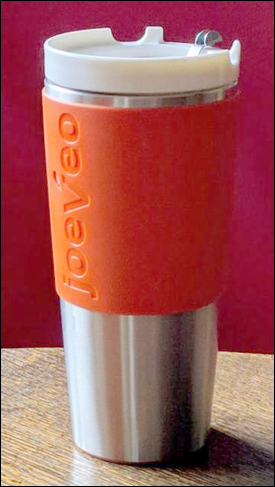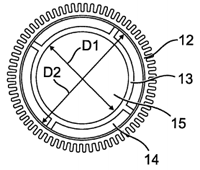 The Phase Change Matters e-mail newsletter is a weekly summary of the latest news and research on phase change materials and thermal energy storage. To subscribe, visit www.puretemp.com/subscribe. For more frequent updates, follow @puretemp on Twitter or visit the Phase Change Matters blog, www.puretemp.com/pcmatters.
The Phase Change Matters e-mail newsletter is a weekly summary of the latest news and research on phase change materials and thermal energy storage. To subscribe, visit www.puretemp.com/subscribe. For more frequent updates, follow @puretemp on Twitter or visit the Phase Change Matters blog, www.puretemp.com/pcmatters.
NEW PRODUCTS
North Carolina company ramps up production of Temperfect mugs
The temperature-controlled coffee mug market heated up a bit this month with word from Joeveo that it has completed the shipment of 5,000 Temperfect mugs to Kickstarter backers. The Wake Forest, N.C., startup is now contacting customers who placed subsequent orders to let them know that their mugs will soon be shipped.
 The 16-ounce mug uses phase change material to cool coffee or tea to a drinkable temperature and keep it there. How is the Temperfect mug ($40-$45) different from two notable competitors, the Ember ($150) and Lexo ($38-$48)?
The 16-ounce mug uses phase change material to cool coffee or tea to a drinkable temperature and keep it there. How is the Temperfect mug ($40-$45) different from two notable competitors, the Ember ($150) and Lexo ($38-$48)?
“The Ember mug is a more complex hybrid PCM/electronic design, 12-ounce rather than 16-ounce like the Temperfect mug, and has a significantly higher price,” said Joeveo’s Dean Verhoeven, who launched the Kickstarter campaign in November 2013. “The electronics and battery of course allow adjustment of the hold temperature, which a straight PCM mug like the Temperfect won’t do.
“The Lexo flask is easier to compare to the Temperfect, as it is strictly PCM-based, and a 16-ounce model is available. The Temperfect mug uses a higher-temperature PCM (61°C vs. 56°C), it’s smaller, lighter and has more of a travel mug design rather than the traditional cylindrical thermos shape of the Lexo. It’s more colorful!
“Lexo offers what I call a ‘backpackable’ lid, whereas the current Temperfect lid is optimized for ease of use in a car cupholder, and not for a hermetic backpack-safe seal.”
Once Joeveo has caught up on current orders, are there plans to sell on Amazon or in coffee shops or brick-and-mortar stores?
“Yes, we’d like to try both,” Verhoeven said. “Brick-and-mortar at some shops we like around here to see what it’s like and to get some experience.”
PATENTS
Temperature controlled packaging and transport method
U.S. patent application 20170198959 (applicant Wool Packaging Co. Ltd., Stone, Great Britain):
“A thermally insulated product delivery container (PDC), including therewithin a rigid shell defining a hollow tube containing wool, first and second tube-end closure boxes containing wool to thereby collectively define an inner void for receiving at least one phase change material container for providing a temperature controlled condition within the void in the presence of a phase change material (PCM), and at least one thermal baffle positionable between the or each phase change material.”
Load bearing structure
U.S. patent application 20170197752 (applicant Airdex Corp., Henderson, Nev.):
“The present invention provides a movable load bearing structure with a surface that includes antimicrobial agents capable of eliminating, preventing, retarding or minimizing the growth of microbes and also minimizing cross-contamination when the load bearing structure is being reused for cargos that differ from a previously transported cargo, for example, different food types, such as poultry, fresh vegetables, and fresh fruit. The load bearing structure may be a dunnage platform or a container for storing and/or shipping cargo. … In an embodiment of the invention, the pockets may be used to locate phase change materials.”
Condenser cylinder adapted for use in an A/C cylinder
U.S. patent application 20170198952 (applicant Valeo Systems Thermiques, Le Mesnil St. Denis, France):
 ”The invention relates to a condenser receiver adapted to receive and house a fluid used in a cold loop of an air-conditioning system, said condenser receiver comprising an outer wall and an inner wall. The inner wall defines an inner space for housing a fluid, while the outer wall is provided on its outer surface with a plurality of ribs that increase the heat exchange between the fluid contained in the inner space and the ambient air outside the condenser receiver. … According to a preferred mode of embodiment of the present invention, the component adapted to store and release a set amount of heat comprises a phase change material [14].”
”The invention relates to a condenser receiver adapted to receive and house a fluid used in a cold loop of an air-conditioning system, said condenser receiver comprising an outer wall and an inner wall. The inner wall defines an inner space for housing a fluid, while the outer wall is provided on its outer surface with a plurality of ribs that increase the heat exchange between the fluid contained in the inner space and the ambient air outside the condenser receiver. … According to a preferred mode of embodiment of the present invention, the component adapted to store and release a set amount of heat comprises a phase change material [14].”
IN BRIEF
• The California Assembly has essentially killed a bill to create a long-term energy storage rebate. The bill, known as SB 700, had earlier cleared the state Senate. The unexpected move pushes consideration of the rebate, which would have applied to a wide range of technologies, including thermal energy storage, into next year.
“Ice Energy and others interested in energy storage for the residential market have closely followed and supported SB 700,” said Ice Energy CEO Mike Hopkins. “The Duck Curve problem is serious and storage is the solution. SB 700 would have significantly accelerated the solution so the delay is disappointing to anyone who cares about replacing fossil fuels with renewables, lowering the cost of power, and improving grid reliability. In the meantime, Ice Energy will continue to work with utilities and utilize SGIP to deliver cost effective and reliable energy storage to the residential market.”• The Hohenstein Institute for Textile Innovation has developed a new method for measuring the cooling effect of intelligent textiles, a heat release tester called WATson. The institute’s thermophysiological evaluation system “will compare the results of the WATson heat loss tester to data from experiments on subjects in a climate chamber under a range of ambient conditions,” Advanced Textiles Source reports.
• For the first time, scientists have recorded water freezing into a structure called Ice VII under extreme, controlled conditions in the lab, Science Alert reports. “These experiments with water are the first of their kind, allowing us to witness a fundamental disorder-to-order transition in one of the most abundant molecules in the Universe,” says geophysicist Arianna Gleason of the Los Alamos National Laboratory in New Mexico.
• A team at the National Institute of Standards and Technology has submitted a precise new calculation of a key formula to redefine the kilogram based on a fundamental universal constant.
• California startup Axiom Exergy, maker of behind-the-meter thermal energy storage systems, has an opening for a computational thermal systems engineer. Axiom announced a deal last week to collaborate with Hillphoenix, a manufacturer of refrigeration equipment used in U.S. supermarkets. The two companies plan to develop and market storage-enabled refrigeration platforms.
RESEARCH ROUNDUP
For our full list of recent academic research, see puretemp.com/academic. Here are highlights from the past week:
From Construction and Building Materials:• Preparation and characterizations of asphalt/lauric acid blends phase change materials for potential building materials
From International Journal of Refrigeration:
• Fabrication of hard-shell microcapsules containing inorganic materials
From Energy:
• Renewable Energy and Energy Storage Systems
• Fabrication and characterization of novel shape-stabilized synergistic phase change materials based on PHDA/GO composites
• Experimental analysis of a coiled stirred tank containing a low cost PCM emulsion as a thermal energy storage system
From International Journal of Photoenergy:
• Thermal Storage Capacity and Night Ventilation Performance of a Solar Chimney Combined with Different PCMs
From International Communications in Heat and Mass Transfer:
• Transient thermal energy storage in partitioned enclosures packed with microencapsulated phase change materials
From Solar Energy Materials and Solar Cells:
• Considerations for the use of metal alloys as phase change materials for high temperature applications
From Applied Thermal Engineering:
• Numerical analysis on the advantage of using PCM heat exchanger in liquid-flow window
• Enhanced melting behavior of carbon based phase change nanocomposites in horizontally oriented latent heat thermal energy storage system
From Building and Environment:
• Research on composite-phase change materials (PCMs)-bricks in the west wall of room-scale cubicle: Mid-season and summer day cases
From Energy and Buildings:
• Dynamic modelling and analysis of a novel latent heat battery in tankless domestic solar water heating
From Solar Energy:
• Thermophysical properties enhancement of ternary carbonates with carbon materials for high-temperature thermal energy storage
From Materials for Renewable and Sustainable Energy:
• Preparation and characterization of 100% bio-based polylactic acid/palmitic acid microcapsules for thermal energy storage
NETWORKING
Connect with PCM experts and industry leaders on LinkedIn
More than 1,100 of your peers have joined a LinkedIn group devoted to the discussion of phase change material and thermal energy storage. The Phase Change Matters group is an interactive complement to the award-winning blog and newsletter of the same name.
 You are invited to join the group and connect with PCM and TES experts from around the world. New members include Michael Brütting, research scientist at ZAE Bayern, Würzburg, Germany; Ahmet Suat Yildiz; technical product engineer, MAN Truck & Bus AG, Ankara, Turkey; Belen Zalba, associate professor at the University of Zaragoza, Spain; and Jonas Larue, global product manager, Alexium International, Greer, S.C.
You are invited to join the group and connect with PCM and TES experts from around the world. New members include Michael Brütting, research scientist at ZAE Bayern, Würzburg, Germany; Ahmet Suat Yildiz; technical product engineer, MAN Truck & Bus AG, Ankara, Turkey; Belen Zalba, associate professor at the University of Zaragoza, Spain; and Jonas Larue, global product manager, Alexium International, Greer, S.C.
Shawn Lee, who joined the group in 2015, recently posted a product announcement:
“Shanghai Tempered Entropy Co. Ltd. has partnered with a China local paraffin wax company to provide food-grade, high-purity paraffin phase change wax with average latent of heat in 200j/g and 220j/g~240j/g in its even higher purity form. We are promoting these food-grade normal paraffin in very competitive price. The 60~70°C food-grade paraffin are ideal for applications in thermal battery/heating pad/health therapy and solar water applications.”